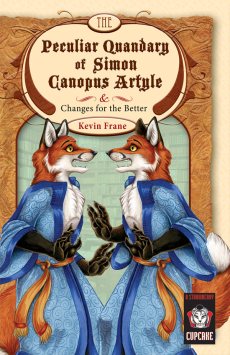Review: 'The Peculiar Quandary of Simon Canopus Artyle', by Kevin Frane
For most of his wizarding life, Simon Canopus Artyle lived in the same splendid little house that was nestled up against the trunk of a giant tree. The tree was an Ephaian Oak, only it was much larger than any normal Ephaian Oak should be, having grown to its inordinate size due to the fact that Simon had spent over two centuries living in proximity to it, and magic flowed through Simon more readily than it did most people, including other wizards. When a wizard lives anywhere, though, giant tree or no, a full-fledged community typically grows up around them within five or six decades, since, as a general rule, a wizard is a very good thing for any town to have (and after this happens, most wizards decide against packing up and leaving, since the inevitable will inevitably happen again, and most simply can’t be bothered to make the effort anyway). (p. 1)
This opening paragraph indicates the leisurely, relaxed style in which Frane presents this somewhat Georgian anthropomorphic comedy of manners. Simon Artyle, a fox wizard of a couple of centuries (although he looks to be only twenty-nine or thirty), is a reader, a lover of books and libraries, to such a degree that other wizards have made him their Grand Historian of Magic, Wizarding, and Spellcraft.
“The Peculiar Quandary of Simon Canopus Artyle”, by Kevin Frane. Illustrated by XianJaguar.
FurPlanet Productions, June 2010, trade paperback $9.95 (vii + 78 pages; also at Amazon).
Simon may be an expert and experienced wizard, but he is a clueless nerd when it comes to personal relationships; especially the attention being shown to him by Miss Valerine Dunnwich, the well-mannered vixen who is “the second eldest daughter of Mayor Dunnwich, the kindly fox who for the past few decades had been in charge of Carina, the town that had sprung up around Simon’s home some two hundred years prior. She came to see Simon several times a week, usually bringing some kind of homemade cakes or biscuits to eat along with afternoon tea”, etc., etc., for five more lines in that sentence. (p. 1)
Simon's assistant, Anton, is not clueless:
Anton Amyclides was officially Simon’s assistant, though he hoped that one day he might be the fox’s apprentice. The raccoon had some minor magical talent of his own, but nothing that yet demonstrated that he was ready to become a wizard. This was part of why he’d been assigned to Simon in the first place: in case it turned out that that aptitude could be honed after all. (p. 5)
Anton offers to excuse himself if Simon would like to be alone with Miss Dunnwich, but Simon doesn’t know what he is hinting at.
Simon is not so dense that he does not notice, after several months, that Miss Dunnwich seems to be showing increasing signs of exasperation towards him. He asks Anton if the assistant has any idea of what could be bothering her? Anton is not sure how to answer that.
Due to an unusual contretemps, Simon is split into two. Or he doubles himself. Whatever. The presence of three males and one female in a relationship resolves itself in an unexpected but satisfactory manner for all involved.
Changes for the Better
This booklet (FurPlanet’s Cupcake #2) is two separate novelettes. “Changes for the Better” originally appeared in Sofawolf Press’ New Fables #1, July 2007. In this semi-sequel, set many years later and several hundred miles away, the ermine wizard (wizardess?) Vanessa Denebola Franciscan finds herself bored, bored, BORED at being assigned to the northern town of Sagitta, where nothing ever happens and which does not need a wizard. This suits her fine; she enjoys her solitude. So when, after a decade, a chubby, snowcovered raccoon townsman, Matthew Ganwick, visits her with a ridiculous personal request, she hears him only to get rid of him – and then, intrigued, decides to grant his wish.
The action and emotion in these two stories is very human, and of a very refined nature. As a comedy of manners, they raise smiles and chuckles rather than outright laughter. But they are unusual for Furry literature, and enjoyable reading. There are enough references to the characters’ furry muzzles, wagging tails, and raised or lowered ears to keep them satisfactorily Furry.
About the author
Fred Patten — read stories — contact (login required)a retired former librarian from North Hollywood, California, interested in general anthropomorphics

Comments
I can haz digital version plz?
Post new comment